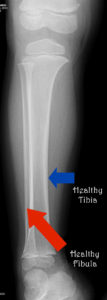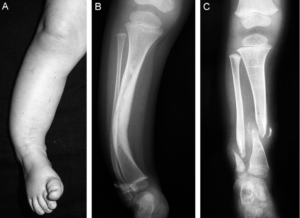Here is a video that explains it well. Gabby’s story gave me so much hope when I needed it most. I hope that it not only explains this condition, but gives you some hope as well.
(Please be aware that this surgeon in NY isn’t taking patients anymore.)
This video is a little longer (20 min). It was made by someone in our community giving a Q&A about how having Congenital Pseudarthrosis (and Neurofibromatosis, Type 1) has affected her life. What an amazing attitude she has! I hope Amy will still have her spunk and brass like this woman does. ♥
Congenital Pseudarthrosis Defined
Congenital Pseudarthrosis of the Tibia (often referred to as CPT) is a very rare condition, occurring in only 1 out of 150,000 to 250,000 children (depending on who you ask). The cause is unknown; however, there is a strong association with Neurofibromatosis (NF) in 50% of cases and and an association with Fibrous Dysplasia in 10% of cases.
CPT refers to the weakening of the tibia (the thicker bone in the lower leg) which eventually leads to a fracture of the tibia. Often the fibula is also involved, however it is almost unheard of for both legs to be affected. This weakening of the bone, causes it to bow, and increases the stress on the pseudarthrosis area, eventually causing a pseudarthrosis fracture.
Pseudarthrosis fractures happen spontaneously or after a minor trauma. A fall from a small step-stool, stepping wrong, or even just standing up could cause a fracture. Worse, once these breaks happen, the bone nearly always fails to heal on its own. A child’s first fracture usually happens within the first two years of life; however, at times fractures can occur later in life, or even before birth.
This condition has no cure, and requires challenging life-long treatment and/or management, but it CAN be managed.
Treatment of CPT is still a challenge. The goal of most physicians is to enable the tibia (and the fibula if affected) to be in one functional, unbroken piece- called union. Additionally, the goal is to strive to prevent limb-length discrepancy, (having one leg shorter than the other) and control or correct other issues effecting the functionality of the limb or pain.
Treatment basics involve some combination of the following:
♦ Casting (short term)
♦ Bracing with a KAFO or AFO (long term)
♦ Surgery
♦ Amputation
Specific treatment, and treatment goals will vary widely from surgeon to surgeon, and patient to patient.
REMEMBER:
♦ Most general orthopedic surgeons will only see 1-2 cases of pseudarthrosis in their career, if they see it at all.
♦ Many general physicians (pediatricians, urgent care, and emergency room personnel) have never even heard of it, so they are unable to recognize it, nor know how to treat it.
♦ Finding an experienced surgeon is the MOST important thing you can do for your child. Do not be afraid to get multiple opinions for your child’s care.
You’re not alone, hang in there.
-Amy’s Mom



2 Comments
Michal lewis · May 22, 2019 at 11:12 am
Hi im new in this feald. My nefue is 7 weeks old. Born with cpt
Is ther a grup that his parents culd be part of so they could lern more?
Thank you so much
Amy’s Mom · May 24, 2019 at 6:08 pm
Hi Michael! I’m so sorry to hear about your nephew. Yes! Help is absolutely out there. Are you on Facebook? If so, there is a fantastic group I have linked above, but here is the address: https://www.facebook.com/groups/lisamcoffee/ The group is in English, but we have many international members who speak many languages.
Are you from Israel? If so, one of our long-time members is from there. I wish you luck, this is a club that no one wants to be a part of.